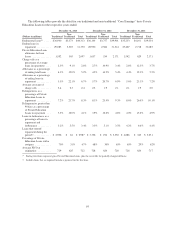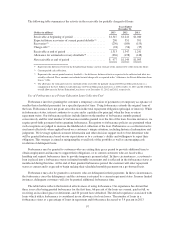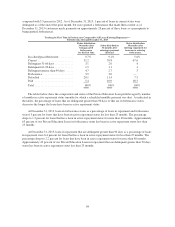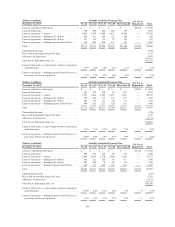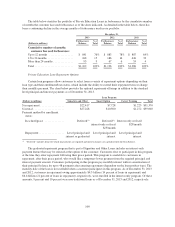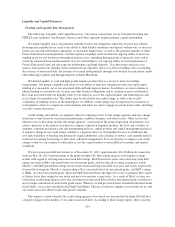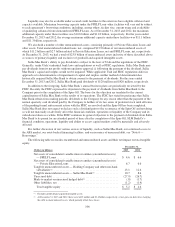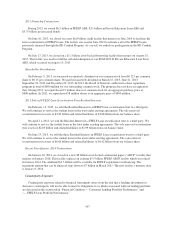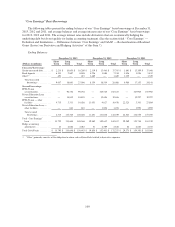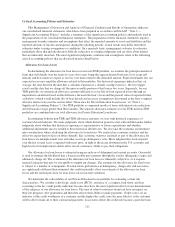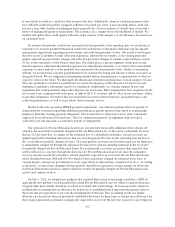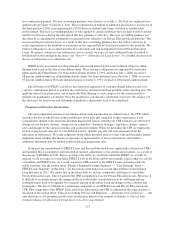Sallie Mae 2013 Annual Report Download - page 106
Download and view the complete annual report
Please find page 106 of the 2013 Sallie Mae annual report below. You can navigate through the pages in the report by either clicking on the pages listed below, or by using the keyword search tool below to find specific information within the annual report.Liquidity and Capital Resources
Funding and Liquidity Risk Management
The following “Liquidity and Capital Resources” discussion concentrates on our Consumer Lending and
FFELP Loans segments. Our Business Services and Other segments require minimal capital and funding.
We define liquidity risk as the potential inability to meet our obligations when they become due without
incurring unacceptable losses, such as the ability to fund liability maturities and deposit withdrawals, or invest in
future asset growth and business operations at reasonable market rates, as well as the potential inability to fund
Private Education Loan originations. Our three primary liquidity needs include our ongoing ability to meet our
funding needs for our businesses throughout market cycles, including during periods of financial stress and to
avoid any mismatch between the maturity of assets and liabilities, our ongoing ability to fund originations of
Private Education Loans and servicing our indebtedness and bank deposits. To achieve these objectives we
analyze and monitor our liquidity needs, maintain excess liquidity and access diverse funding sources including
the issuance of unsecured debt, the issuance of secured debt primarily through asset-backed securitizations and/or
other financing facilities and through deposits at Sallie Mae Bank.
We define liquidity as cash and high-quality liquid securities that we can use to meet our funding
requirements. Our primary liquidity risk relates to our ability to fund new originations and raise replacement
funding at a reasonable cost as our unsecured debt and bank deposits mature. In addition, we must continue to
obtain funding at reasonable rates to meet our other business obligations and to continue to grow our business.
Key risks associated with our liquidity relate to our ability to access the capital markets and bank deposits and
access them at reasonable rates. This ability may be affected by our credit ratings, as well as the overall
availability of funding sources in the marketplace. In addition, credit ratings may be important to customers or
counterparties when we compete in certain markets and when we seek to engage in certain transactions, including
over-the-counter derivatives.
Credit ratings and outlooks are opinions subject to ongoing review by the ratings agencies and may change
from time to time based on our financial performance, industry dynamics and other factors. Other factors that
influence our credit ratings include the ratings agencies’ assessment of the general operating environment, our
relative positions in the markets in which we compete, reputation, liquidity position, the level and volatility of
earnings, corporate governance and risk management policies, capital position and capital management practices.
A negative change in our credit rating could have a negative effect on our liquidity because it would raise the
cost and availability of funding and potentially require additional cash collateral or restrict cash currently held as
collateral on existing borrowings or derivative collateral arrangements. It is our objective to improve our credit
ratings so that we can continue to efficiently access the capital markets even in difficult economic and market
conditions.
We have unsecured debt that totaled, as of December 31, 2013, approximately $18.3 billion. In connection
with our May 28, 2013 announcement of the proposed Spin-Off, three rating agencies took negative ratings
actions with regard to our long-term unsecured debt ratings. Fitch lowered its senior unsecured long-term debt
rating one notch to BB+, one notch below its investment grade, and also placed its rating on negative watch.
Moody’s and S&P placed their ratings on our senior unsecured long-term debt on review and watch, respectively,
for possible downgrade. Moody’s current rating is Ba1, one notch below its investment grade, and S&P’s rating
is BBB-, its lowest investment grade. Fitch and S&P indicated that if the Spin-Off occurs as planned, they expect
to further lower their ratings by one notch and up to two notches, respectively. As a result of Fitch’s action, two
of the three credit rating agencies now rate our long-term unsecured debt at below investment grade such that we
are no longer considered an investment grade issuer. Whereas we had previously been included in the Investment
Grade Index, we are now included in the High Yield Index. This has resulted in a higher cost of funds for us, and
our senior unsecured debt to trade with greater volatility.
The negative actions taken by the credit rating agencies were based on concerns that the Spin-Off will have
a negative impact on the holders of our senior unsecured debt. According to their ratings reports, these concerns
104



